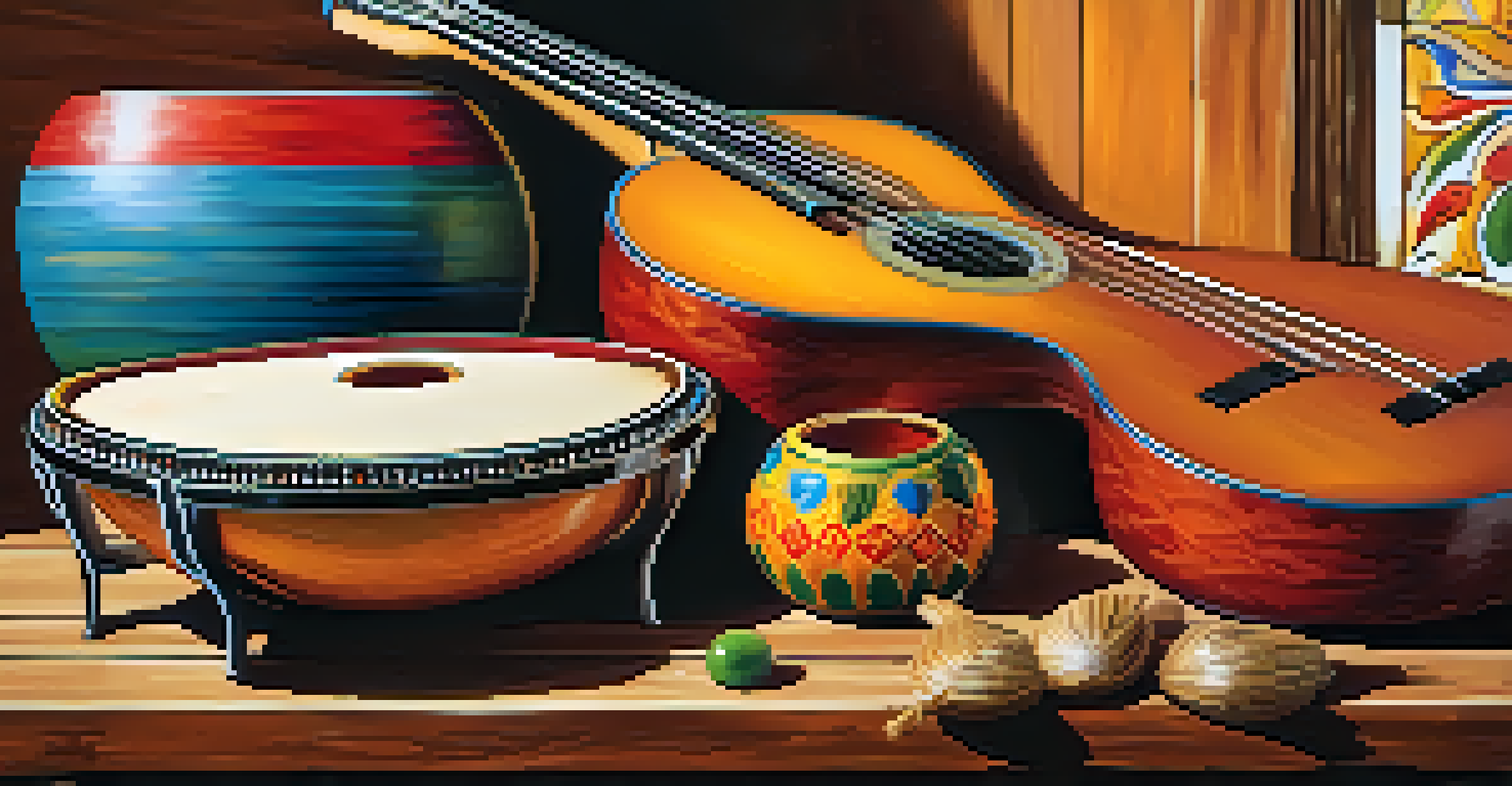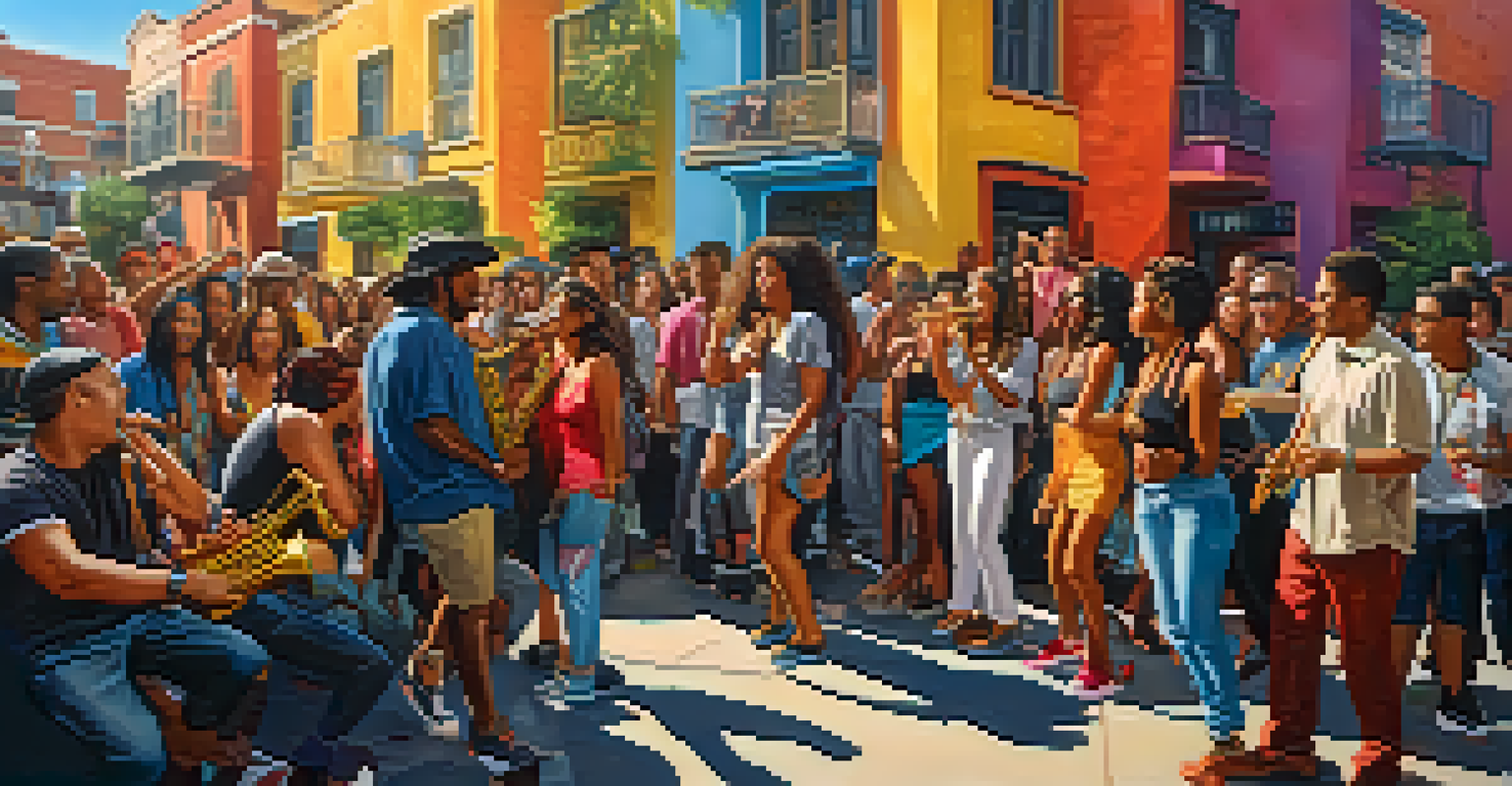The Influence of Latin Music on Global Music Trends Today

The Rise of Latin Music in the Global Arena
Latin music has surged in popularity over the last two decades, captivating audiences worldwide. Artists like Shakira and Daddy Yankee have not only topped charts but also brought Latin rhythms into mainstream pop. This rise can be attributed to the fusion of traditional Latin sounds with popular genres, creating a fresh and infectious vibe.
Music is the universal language of mankind.
Streaming platforms have played a pivotal role in this phenomenon, making Latin tracks accessible to a global audience. For instance, Bad Bunny's unique blend of reggaeton and trap music has garnered millions of listeners, leading to collaborations with global superstars. The digital age has paved the way for Latin music to permeate cultures far beyond its origins.
As Latin music continues to thrive, it highlights the importance of cultural exchange in the music industry. The genre's infectious beats and vibrant lyrics resonate with a diverse audience, proving that music has no boundaries. This newfound visibility has sparked interest and appreciation for Latin culture as a whole.
Key Genres Shaping the Latin Music Landscape
Latin music is a diverse tapestry of genres, each contributing to its global influence. Salsa, merengue, bachata, and reggaeton are just a few styles that have captivated listeners. Each genre brings its own flair, showcasing the rich cultural heritage of Latin America and its ability to evolve over time.

Reggaeton, in particular, has emerged as a dominant force, blending hip-hop elements with Latin beats. Artists like J Balvin and Ozuna have made this genre a staple in dance clubs worldwide. The catchy rhythms and relatable themes resonate with audiences across different demographics, making reggaeton a global phenomenon.
Latin Music's Global Popularity Soars
The fusion of traditional Latin sounds with contemporary genres has propelled artists like Shakira and Bad Bunny into the global spotlight.
Moreover, the fusion of genres is not limited to Latin music alone. Collaborations with artists from various backgrounds have resulted in innovative sounds that appeal to a broader audience. This cross-pollination of musical styles demonstrates how Latin music continues to inspire and influence artists around the world.
Cultural Influences of Latin Music on Global Artists
Latin music's impact is evident in the work of many international artists who draw inspiration from its vibrant rhythms. Pop icons like Rihanna and Justin Bieber have incorporated Latin elements into their songs, reflecting the genre's growing significance. This blending of styles not only enhances their music but also introduces Latin culture to new audiences.
The beauty of music is that it transcends language and cultural barriers.
For example, the hit single 'Despacito' by Luis Fonsi and Daddy Yankee became a global sensation, prompting numerous remixes and covers by various artists. Its infectious beat and catchy chorus transcended language barriers, showcasing the universal appeal of Latin music. Such collaborations have become increasingly common, highlighting the genre's influence on mainstream music.
As artists embrace Latin music, they contribute to a more diverse musical landscape. This cultural exchange enriches the global music scene, allowing for fresh sounds and ideas to emerge. The influence of Latin music extends beyond mere trends; it fosters a deeper understanding and appreciation of diverse cultures.
The Role of Social Media in Promoting Latin Music
Social media platforms have revolutionized how music is shared and consumed, playing a crucial role in the rise of Latin music. Artists leverage platforms like Instagram, TikTok, and YouTube to connect with fans and showcase their work. Viral dance challenges and trends centered around Latin songs have further propelled their popularity.
For instance, the 'Savage Love' dance challenge, which featured a remix with Latin artist Jawsh 685, brought attention to both the original track and the influence of Latin sounds in contemporary music. These platforms enable artists to reach wider audiences, often leading to chart-topping success in various countries.
Social Media Fuels Latin Music Growth
Platforms like Instagram and TikTok have revolutionized music promotion, enabling Latin artists to reach wider audiences through viral trends and challenges.
Moreover, social media provides a space for fans to engage with artists and share their love for Latin music. This community-building fosters a sense of belonging and excitement around new releases. As a result, social media has become an essential tool for Latin artists looking to expand their reach and impact.
Latin Music Festivals and Their Global Impact
Latin music festivals have become cultural phenomena, attracting diverse crowds and showcasing the genre's richness. Events like Coachella and Lollapalooza have embraced Latin acts, further integrating them into mainstream music culture. These festivals not only highlight established artists but also provide a platform for emerging talent.
The success of Latin festivals, such as the Latin Grammys and the Billboard Latin Music Awards, emphasizes the genre's growing influence within the industry. These events celebrate the achievements of Latin artists and foster a sense of unity among fans. They also serve as a reminder of the importance of recognizing and honoring cultural contributions to the music world.
Furthermore, these festivals encourage collaboration between artists from different backgrounds, leading to innovative performances that captivate audiences. The vibrant atmosphere and lively performances create unforgettable experiences that resonate with attendees. As Latin music continues to flourish, these festivals will play a vital role in shaping its future.
Challenges Facing Latin Music in the Global Market
Despite its success, Latin music faces several challenges in the global market. One significant hurdle is the language barrier that may deter some listeners from fully engaging with the music. While catchy beats can draw people in, understanding the lyrics is essential for a deeper connection to the songs.
Additionally, the music industry is incredibly competitive, with countless genres vying for attention. Latin artists must work hard to maintain their visibility in a crowded market, often relying on strategic collaborations and marketing efforts. This pressure can be daunting, but it also encourages innovation and creativity.
Festivals Showcase Latin Music's Richness
Latin music festivals, such as the Latin Grammys, celebrate cultural contributions and foster collaboration among diverse artists, enhancing the genre's global influence.
Furthermore, the rapid evolution of music consumption trends means that Latin artists must stay ahead of the curve. Adapting to changes in technology and audience preferences is crucial for long-term success. By embracing these challenges, Latin music can continue to thrive and evolve in an ever-changing global landscape.
The Future of Latin Music and Its Global Influence
The future of Latin music looks promising, with its influence expected to grow even further. As more artists incorporate Latin elements into their work, the genre will continue to shape global music trends. This ongoing evolution demonstrates the adaptability and resilience of Latin music in the face of change.
Emerging artists are also bringing fresh perspectives and sounds to the genre, ensuring its relevance for years to come. The fusion of Latin music with other styles, such as electronic and indie, opens up new avenues for creativity and exploration. This diversity will only enhance the global appeal of Latin music.

Ultimately, the rise of Latin music is a testament to the power of cultural exchange and collaboration. As the world becomes more interconnected, the appreciation for Latin music will likely continue to grow, fostering a deeper understanding of its rich cultural heritage. The journey of Latin music is far from over, and its global impact will only expand in the years ahead.